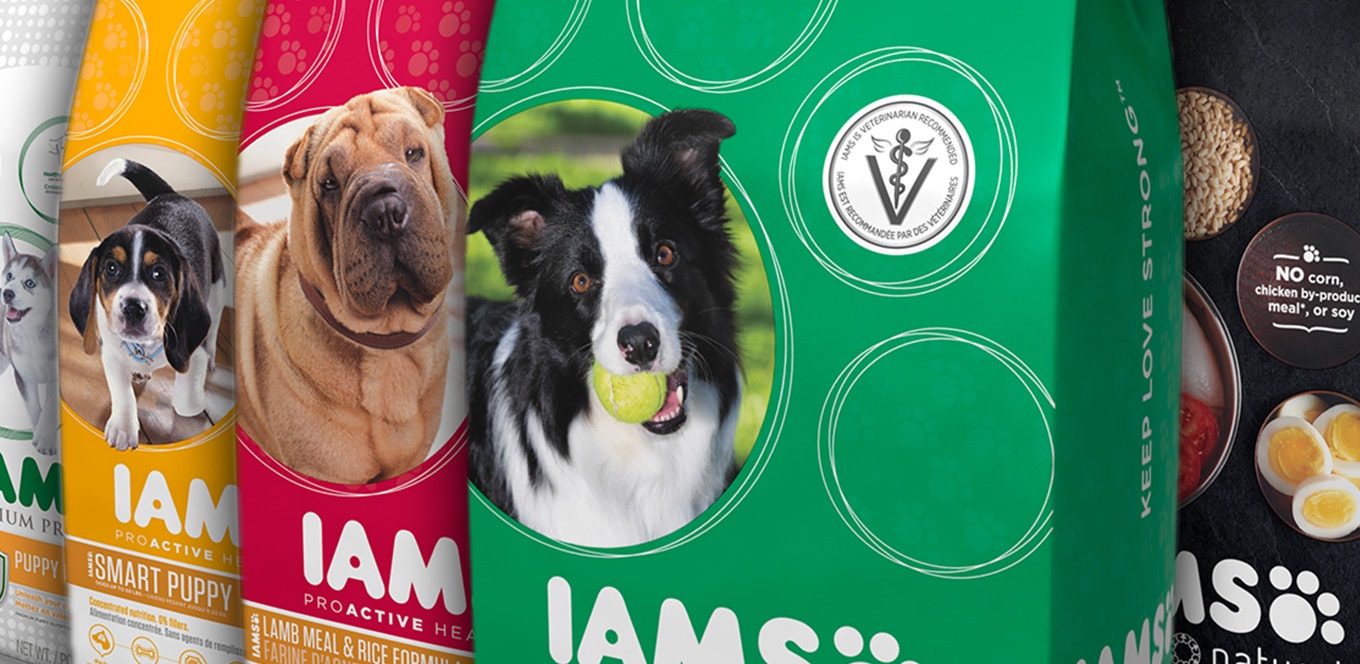

Good nutrition is as important to your dog’s health as it is to your own. But with thousands of different pet foods available, how do you pick the right one for your dog?
Learn how to choose a dog food that provides the proper, balanced nutrition your dog needs to thrive with these six tips.
In general, while a human diet should be high in fiber and low in fat, a dog needs more fat for energy and a healthy skin and coat, and less fiber for good intestinal health.
Preferably, a dog’s food should include meat, too. Even if you prefer a vegetarian diet, designing a high-quality dog diet without animal protein is difficult. IAMS™ Company research supports that meatless meals might not provide optimal nutrition for dogs. Dogs are best fed as carnivores because they have simple stomachs and short intestines that are ideal for digesting animal protein and animal fat. Dogs also need carbohydrates for energy.
Start by identifying your dog’s life stage and lifestyle. Puppies, nursing mothers and mature pets each represent different life stages, and each one has different nutritional requirements. By law, all dog foods must state the life stage for which they are recommended.
Nutritional needs also vary depending on lifestyle. A dog whose primary activity is guarding the couch doesn’t need as much energy as one who guards a flock of sheep. Another factor to consider is breed size: small, medium or large.
Finally, consider medical conditions your dog has, such as food allergies, that might require your veterinarian to recommend a special diet.
Once you’ve determined your dog’s life stage and lifestyle needs, decide whether to feed him dry or canned food. Most dogs do well eating only dry food. Dry foods promote oral hygiene for healthy teeth and gums through abrasive chewing action. Some dogs, especially finicky eaters, enjoy wet food because of its smooth, wet texture.
Remember that while dry food can be left in a bowl all day, wet food should be thrown away after 30 minutes if not consumed. Dry food is the best choice for busy people who are not normally home during the day.
After you determine your pet’s nutritional needs and preference, you are ready to go shopping.
Ingredients on dog-food labels are listed in descending order according to weight. Because dogs thrive on animal-based diets, it’s best to pick a food that features an animal-based protein source, such as chicken, lamb, fish or egg, as the first ingredient. Unlike a single-vegetable-based protein source, such as soybean meal or corn-gluten meal, animal-based protein sources contain adequate amounts of essential amino acids.
Scientific studies show that a combination of carbohydrates in the diet, such as corn meal or barley and grain sorghum, offers optimal carbohydrate digestibility and helps maintain energy levels. In addition, scientific studies show that beet pulp — the material remaining after sugar is extracted from sugar beets — is an excellent fiber source and promotes a healthy digestive tract. Finally, for a glossy coat and healthy skin, your pet needs fat in the diet. Good fat sources include chicken fat and fish oil.
Dog-food labels provide limited information about the nutritional value of the food because labeling regulations do not allow manufacturers to describe the quality of ingredients on the package.
A reputable pet-food manufacturer will be able to explain their specific methods for evaluating and assuring the quality of ingredients used in its products.
When choosing food, the price on the bag, while important, is usually not the best consideration. A low price might indicate inexpensive ingredients, or ingredients that change as market prices fluctuate.
Also, many lower-priced products have higher daily portions to provide the same amount of nutrition found in a high-quality diet. To get a better representation of value, it is the cost per feeding, not the total cost, that counts.
To figure cost per feeding, divide the total cost by the number of days the product lasts. For example, a 20-pound bag of food costs $18.99 and lasts 30 days. The cost to feed is $0.63 per day. A 20-pound bag of food that costs $15.99 and lasts 20 days costs $0.80 per day. So, when costs are analyzed properly, high-quality pet foods compare quite favorably to other brands while offering outstanding nutrition.




As a pet parent, it's hard to hear your furry friend crying. It can be due to separation anxiety, fear, or illness and can be frustrating to deal with. This article will provide practical tips on stopping your pup from crying and help them feel more comfortable and secure. We will guide you through establishing a routine and using calming aids to help your puppy stop crying and live a happier, more peaceful life.
Crying in puppies can vary depending on their age. Older puppies may cry because they are experiencing separation anxiety, are bored, or need to go outside. Meanwhile, newborn puppies cry because they are hungry, uncomfortable, or need warmth. Pay attention to why your puppy cries, so you can provide it with the right care and comfort.
If you are wondering why your pup is crying and how to put a stop to it, the key is to understand the underlying reasons. By gaining this knowledge, you can take the appropriate steps to address the problem and silence the crying. Keep reading to learn more about stopping your pup's tears.
As delicate and helpless beings, newborn puppies rely on their mothers or caregivers to provide for their basic needs. When hungry, cold, or sick, they often cry out in distress, it is like their tiny voice is seeking help. It can be heart-wrenching to hear their cries as they struggle to communicate their needs.
At this stage, the puppies must receive proper care and attention for survival. This may involve giving them warm, nutritious milk from their mothers or finding a suitable substitute if the mother cannot feed them. Providing the puppies with the necessary care will ensure their health and well-being.
In certain situations, puppies may need to receive medication or other forms of treatment to help them recover from an illness or infection. This can be a delicate and complex process, requiring close monitoring and expert knowledge to ensure that puppies receive the appropriate level of care.
As puppies grow older, they often become more vocal when they need to go outside to play or relieve themselves. This can manifest in whining or barking at the door and scratching at it with their paws to grab someone's attention. While this behaviour is natural for puppies, it can be frustrating for their caregivers, particularly when they are trying to get some rest or focus on work.
As a pet parent, providing enough exercise and mental stimulation is important to keep your puppy happy and engaged. If your older puppy is crying or whining, it could signify that they are bored and need entertainment. They may start pacing or circling the room, looking for something to do. If you notice your puppy exhibiting these behaviours, consider taking them for a walk or providing them with a fun new toy to play with.
As puppies grow older, they may become restless and cry when they are tired or ready for bed. This is typical behaviour among puppies, but it can be disruptive for the pet parent. To help your pup settle down for the night, try implementing a bedtime routine and providing a comfortable, cosy bed for it to sleep in. This will not only help your puppy feel more at ease but also allow you to get a good night's rest.
As a responsible pet parent, it's crucial to identify the reasons behind your puppy's crying and take appropriate steps. Whether it's hunger, fear, or loneliness, addressing these underlying causes can create a happier and more comfortable environment for your furry friend. By understanding the root causes of your puppy's crying, you can also provide your canine companion with necessary support and affection to help them feel loved and at ease. Here are some common reasons why puppies may cry:
Suppose your puppy is crying and showing other symptoms of illness. In that case, it could be due to several reasons, ranging from a respiratory infection to a more severe condition such as parvo or distemper. Keep an eye on your puppy's behaviour and pay attention to any changes that may indicate a health problem, so you can act quickly and prevent any potential complications. It is crucial to take your furry friend to the vet as soon as possible for a proper diagnosis and treatment, especially if the crying continues or is accompanied by other signs of discomfort or distress.
As puppies have small stomachs, they require more frequent meals than adult dogs. It's important to provide them with regular, balanced meals and snacks throughout the day to ensure their well-being and happiness. If your puppy is crying and has not eaten in a while, it may be asking for food.
If your puppy is crying, it may be because they feel lonely and neglected. To prevent this, spend quality time with your pup daily. Engage in activities like playing, training, and bonding with them to create a strong, positive relationship and prevent feelings of loneliness.
Puppies overflow with energy and require significant stimulation to stay content and healthy. If your furry friend is crying and appears restless or fidgety, it could be because they are bored and need something to do. Provide your puppy with various toys, games, and activities to keep them entertained and focused.
Suppose your puppy is crying and appears frightened. In that case, it may be because of loud noise, a scary situation, or even a sudden change in their environment. To help calm them down, try speaking softly, offering a treat, or playing soothing music. If the fear continues, seeking the assistance of a professional trainer or behaviourist may be necessary to help your puppy overcome its anxiety.
If your puppy is used to being around other dogs or people and is suddenly left alone for long periods of time, they may become lonely and cry. To prevent this, consider providing your puppy with a companion like another dog or a stuffed animal. Additionally, ensure your puppy has regular opportunities to socialise and interact with others to prevent loneliness and unhappiness.
Consoling a crying puppy can be a challenging and emotional task. Still, making your furry friend feel safe and loved is essential. Here are a few tips to help comfort a crying puppy:
To successfully comfort a crying puppy, it is crucial to have patience and an understanding of what may be causing distress. Once the source of the crying is determined, providing the appropriate support and can help stop its tears and give the puppy a feeling of safety. If needed, seeking advice from a professional can also be beneficial in these situations.